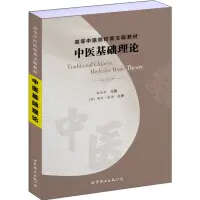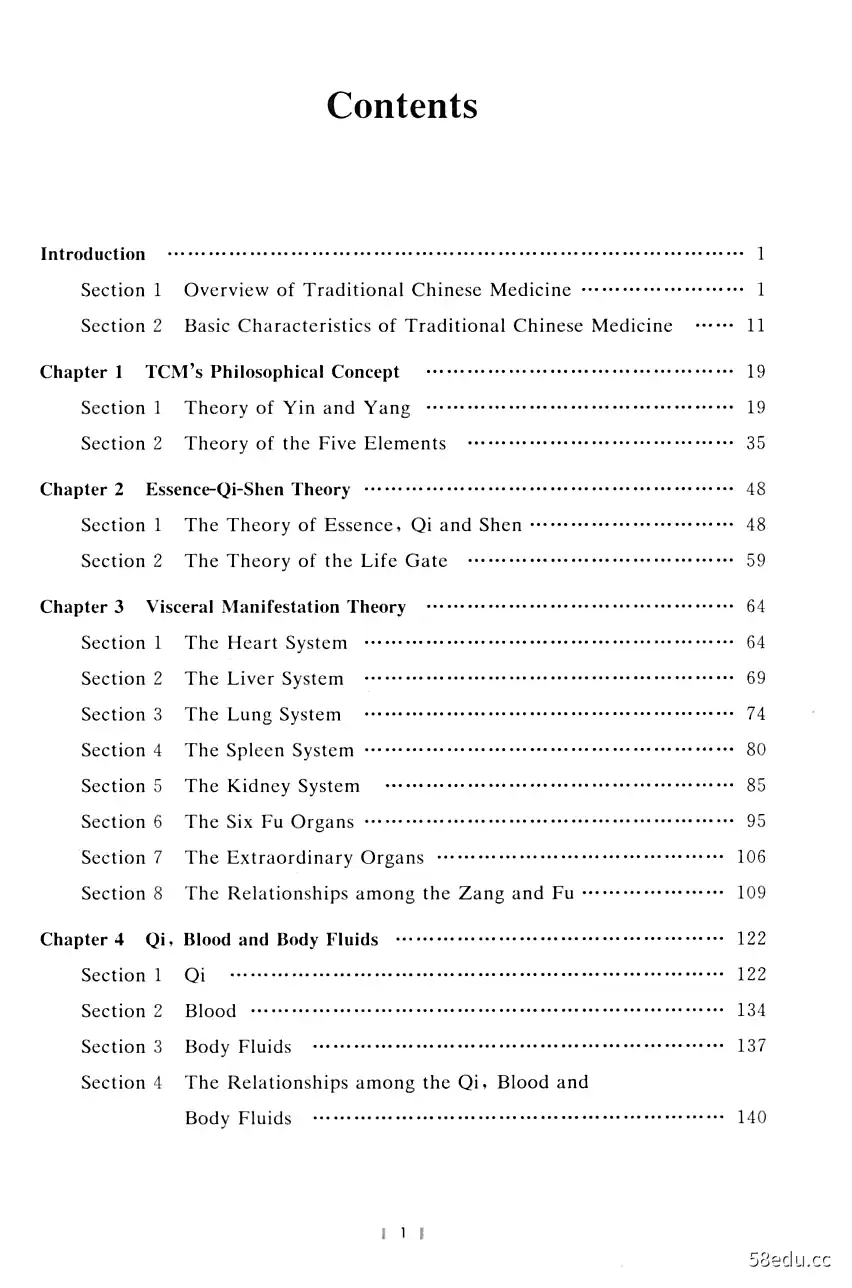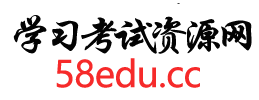《中医基础理论》曲丽芳主编|(epub+azw3+mobi+pdf)电子书下载
图书名称:《中医基础理论》
- 【作 者】曲丽芳主编
- 【丛书名】高等中医院校英文版教材
- 【页 数】 237
- 【出版社】 上海:上海世界图书出版公司 , 2018.04
- 【ISBN号】978-7-5192-4083-7
- 【价 格】58.00
- 【分 类】中医医学基础-教材-英文
- 【参考文献】 曲丽芳主编. 中医基础理论. 上海:上海世界图书出版公司, 2018.04.
图书封面:

图书目录:


《中医基础理论》内容提要:
本书包括中医哲学 (阴阳五行学说) 、中医生命观 (精气神学说) 、藏象学说、气血津液学说、经络学说、病因病机学说、养生防病学说、治则治法等内容。
《中医基础理论》内容试读
Introduction
Section 1 Overview of Traditional Chinese Medicine
Traditional medicine is an important part of Chinese culture and civilization,because it has been practiced in China for over ten thousand years.Chinesemedicine's profound and unique theories therefore are based on a wealth ofvaried clinical experiences.The field of traditional Chinese medicine deals withhuman physiology,psychology and pathology,as well as the prevention andtreatment of diseases.
Worldwide,Chinese medicine is an outstanding traditional medicines.Itsalignment with thousands of years of Chinese civilization has enabled anextraordinary concentration of observation and experience from which havearisen a unique theoretical basis and a practical system of life sciences andtherapeutics.Today traditional Chinese medicine reminds us of a way ofunderstanding life phenomenon that is different from modern medicine.Itoffers us many ideas to cultivate one's person physically and mentally,andadapt our way of life to a more natural simple outlook.
Traditional Chinese medicine is built on the rich tradition of practicalexperience and unique therapeutic techniques,and many medical miracles wererecorded over the thousands of years struggle against disease.Therefore
Chairman Mao Zedong declared in the late 1950s,"Chinese medicine is a greattreasure-house that we should excavate and improve."
1.1 Basic concepts of Traditional Chinese Medicine
Chinese medicine (CM)or Traditional Chinese medicine (TCM)is China'soriginal field of Medicine.Actually in Chinese Culture,Chinese Medicinezhongyi)is not the same as its translation in English.In Chinese culturezhong (middle or medium)is a philosophical concept that means to maintainbalance and harmony.This is the Confucian philosophy of maintaining the
Golden Mean(中庸zhongyong).
I 1 I
Traditional Chinese Medicine Basic Theory
The essence of modern science is to apply quantitative research to thenatural world,and the Chinese word for science kexue)captures thisidea.The character科ke consists of禾he and斗dǒu.Originally,禾he meant"millet",and later its meaning included all kinds of cereals.Dou is a kind ofmeasuring vessel in ancient China Figure 1).Yet,not every aspect of thenatural world can be measured and quantified,and this is one essentialdifference between traditional Chinese medicine and modern medicine.
The harmony of yin and yang in dynamic balance is another meaning forzhong.This concept is concisely summarized by the Taiji diagram (Figure 2).
Rather than the kind of knowledge produced by experimental scientificmaterialism,traditional Chinese medicine has its roots in a form of speculativephilosophy based on observation and practice.
Figure1斗dou
Figure 2 Taiji diagram
Why is the Taiji diagram round?Because in Chinese philosophy and culturethe round shape represents insubstantial and invisible form,while the squareshape,such as that of the dou,represents substantial,quantifiable,andmaterial objects.
1.2 The historical development of Chinese medicine
Traditional Chinese medicine has been developing continuously in China forover ten thousand years.In the New Stone Age (around 10,000-4,000 BC)implements made of stone were used therapeutically,for example,to inciseabscesses,or for blood-letting.Stone needles bianshi zhen used in the
Stone Age,4.5 cun (14 cm)long,have been excavated in the Province of Inner
Mongolia.
1.2.1 Outstanding sages
From the time preceding the Xia Dynasty (around 2070-1600 BC),three
121
Introduction
important emperors,had an outstanding influence on Chinese civilization,culture and medicine.They were Fuxi,Shennong and Huangdi.
Fuxi伏羲
Fuxi was the first legendary ancestor of the Chinese people.He and thegoddess Nuwa(女娲NiWa)were born in Chengji(成纪Chengji)Jingning(静
Jingning),Tianshui city,in present-day Gansu Province.Fuxi was said tohave introduced hunting and fishing,and to have invented cooking.
Fuxi is the first author of the first book of Chinese philosophy,the Book of
Changes(易经Yijing).He discovered its linear signs,the Eight Trigrams(八卦
Bagua)(Figure 3).Later,the other two main authors were King Wen of Zhou(周文王Zhou Wenwáng,11521056BC)and Confucius(f孔子Kǒngzi,551
479BC).
Figure 3 The Eight Trigrams
The Book of Changes is the root and core of Chinese philosophy andestablished the basis of Chinese culture.Its Eight Trigrams summarize theancient Chinese worldview and ways of knowing (cosmology and epistemology).
Ancient Chinese cosmology described a universe consisting of time andspace.The Eastern Han Dynasty's Dictionary of Words and Expressions
Shuowen Jiezi,100-121)has the first recorded description of the universe:"Up,down and the four directions of east,west,south and north are calledspace.Coming and going (future and past)are called time."So the space has sixdirections,and time has two.Because time and space are always together,theuniverse consists of six dimensions of space and two dimensions of time.
The Eight Trigrams represent these eight dimensions of space-time.Theyindicate that the ancient Chinese sages saw natural phenomena and human lifeas existing in an octuple of space-time,rather than the three-or four-dimensionalnotions of space-time we think of nowadays.This is another key point thatdistinguishes the theoretical system of Chinese medicine from that of the
modern medicine.
131
Traditional Chinese Medicine Basic Theory
The Book of Changes also became the guiding philosophy for Chinesemedicine.It influenced Chinese medicine from its very beginnings,shaping itsway of thinking and epistemic methods.Just as Albert Einstein (1879-1955)said,"Philosophy is the mother of all sciences";and as the Chinese saying goes,“Medicine and the(Book of)Changes are interlinked”(医易相通yiyixiangtong).Philosophy decides the way of thinking.This means that in order tolearn about or comment on Chinese medicine,one must first understand the
Book of Changes;and to be a good practitioner,it is essential to understand the
Book of Changes.
Shennong神农
Legendary Emperor Shennong,also known as the“Red Emperor”(炎帝
Yandi),was the forefather of the Chinese people.He is said to have introducedagriculture and the rearing of domestic animals,and is known as the world'sfirst pharmacist.An ancient legend says that,"After tasting all kinds of plantsand water from springs,Shennong was able to tell the people which were goodfor them".There was a time when he was poisoned seventy times a day.
To respect Shennong's contributions to botany and the materia medica,thesecond classic of Chinese medicine (see section 3.4 below)was named afterhim:Shennong'sClassic of Materia Medica(神农本草经Shennong Bencaojing).
This work is the first monograph of Chinese medicinal substances,and laid thefoundation for China's famous pharmaceutical tradition.The book is thecollection of all pharmaceutical knowledge up to the Han Dynasty.It recorded365 medicinal items,among which 252 are derived from plants,67 fromanimals,and 46 from mineral substances.
Medicinal substances have been referred to in many books dating back tothe Xia,Shang,and Zhou Dynasties(around 2070-221 BC).Early works suchas the Classic of Poetry(诗经Shijing)and the Classic of Mountains and Seas(山
Shanhaijing)also mention them.Over fifty types of herbs are mentionedin the Classic of Poetry.It is Chinese earliest collection of poetry and we can seefrom its contents that the practice of collecting herbs was already prevalent.
Huangdi黄帝
Huangdi(黄帝Huangdi)is the legendary“Yellow Emperor”,a culturalhero and the ancestor of the Chinese race.He was successor to the Red
Emperor,and was said to have invented the compass,built a planetarium,calculated a calendar,and brought bamboo to China.His queen is thought tohave discovered silkworm cultivation.
14
Introduction
The Yellow Emperor's Inner Canon(黄帝内经Huangdi Neijing)establishedthe theoretical system of Chinese medicine.The content of the Yellow
Emperor's Inner Canon consists of discussions between Huangdi and his seniorofficers,such as Qibo Oibo).The dialogue between Huangdi and Qibo isthe reason why Chinese medicine is also called the techniques of "Qi-Huang".
1.2.2 Outstanding practitioners
Many famous physicians made great contributions to the historical developmentof Chinese medicine.Their influence on later generations extends to bothclinical practice and theoretical research.
Bianque扁鹊
Bianque (5h-4th centuries BC)was a famous physician and paediatrician,who lived during the Warring States period (475-221 BC).He is the firstmedical figure.for whom we have some biographical details.Bianque treatedpatients using acupuncture,moxibustion,herbs and massage,and he is thoughtto have developed the Four Diagnostic Methods.
Zhang Zhongjing张仲景
Zhang Zhongjing (around 152-219)was born in Nanyang county of
Henan Province.His family name was Zhang,given name Ji,and style
Zhongjing.It is said that he learned medicine from Zhang Bozu,who handeddown all his knowledge to Zhang Zhongjing.Zhang Zhongjing was a famousdoctor of his own time in the Eastern Han Dynasty,and was highly respected asa sage of Chinese medicine by later generations.
The fame and respect given to Zhang is due to the fact that he initiated
Chinese medicine's unique system of syndrome differentiation and treatment.
He laid the foundation of herbal formula prescriptions,as well as the science ofprocessing Chinese medicinal substances.He pioneered Chinese medicinespecialist practices,such as internal medicine,gynaecology,surgery,nursingand dietary therapy.
All these landmark innovations are recorded in his great work,the Treatiseon Cold Damage and Miscellaneous Diseases(伤寒杂病论Shanghan Zabinglun).
Soon after the Eastern Han,Zhang's treatise was edited and divided into twobooks:Treatise on Cold Damage(伤寒论Shanghanlun)and Essential
Prescriptions of the Golden Cabinet(金匮要略Jingui Yaolue).
Hua Tuo华佗
Hua Tuo (?-208)is perhaps the best known of all Chinese doctors.His
151
Traditional Chinese Medicine Basic Theory
specialties included internal medicine,gynaecology,paediatrics,acupuncture,andsurgery.He is credited with being the first doctor in the history of the world toperform intra-abdominal surgery,for which he use a herbal preparation foranaesthesia.
Hua Tuo's another outstanding contribution was the "Five Animal
Exercises'”(五禽戏wuqinxi),a kind of health gymnastics that is still practicedby Chinese people today.He believed that,"The body needs exercise to promotecirculation so that it will be free of diseases,just as a door hinge is never worm-eaten.”
Ge Hong葛洪
Ge Hong (around 284-364)was born in Danyang,Jiangsu Province.Hisstyle was Zhichuan(稚川),and he was also known as Baopuzi(抱朴子).Hewas a scholar of Daoism in the Eastern Jin Dynasty (317-420),and wrote thefamous Baopuzi(抱朴子)and the Handbook of Emergency Prescriptions(肘后备
Zhouhou Beiji Fang)-well-known texts for promoting health and prolonginglife.He is also remembered as an alchemist and medical expert.He observed inmatter changes when making elixirs,and is famous as the pioneer of pharmaceuticalchemistry.
In 340 Ge Hong was the first to describe antimalarial properties Artemisiaannua's Tu Youyou 1930-)was awarded the Nobel Prize for Medicine in2015 as one of the researchers who developed a process for extracting artemisinin.
Nowadays,artemisinin is regarded as the panacea for treating malaria,and Tu
Youyou says her research was influenced by Ge Hong.
1.3 Chinese medicine's Heoretical frameworks:the four classic works
When we consider development of Chinese medicine over thousands ofyears,we can see its theoretical system is similar to a very large tree withspreading branches and luxuriant foliage.There are many schools,such as theschool of cold damage,the school of warm diseases,the school of classicprescriptions,and so on.There are many specialties,such as internal medicine,gynaecology,pediatrics and acupuncture,as well as an immense archive oftexts.Yet,all of these depend upon the four classic works that are the root,trunk and core of Chinese medicine.
The four classic works that have established fundamental framework of
Chinese medicine's are the:
161
···试读结束···


